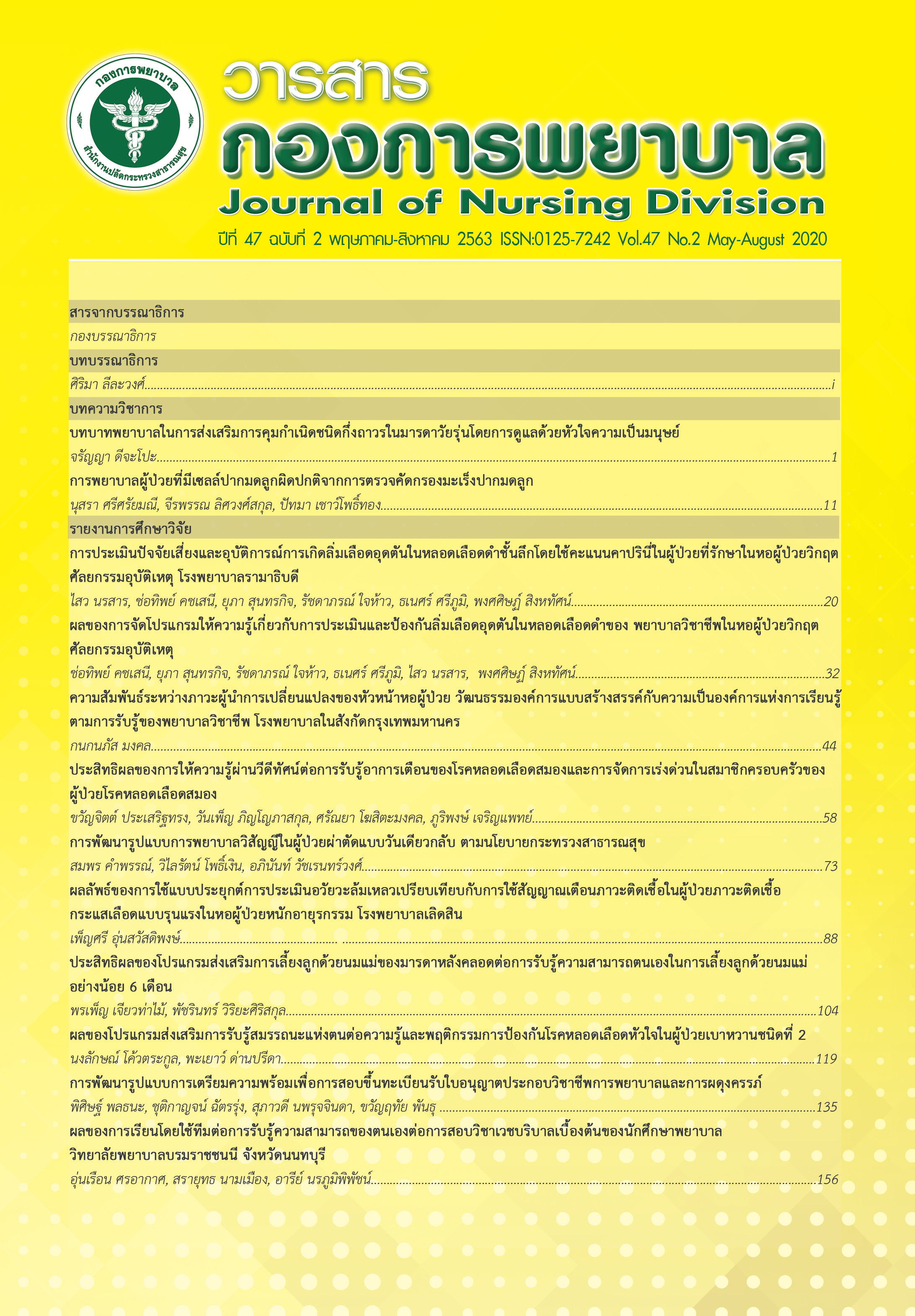ผลลัพธ์ของการใช้แบบประยุกต์การประเมินอวัยวะล้มเหลวเปรียบเทียบกับการใช้สัญญาณเตือนในผู้ป่วยภาวะติดเชื้อกระแสเลือดแบบรุนแรงในหอผู้ป่วยหนัก อายุรกรรม โรงพยาบาลเลิดสิน
Main Article Content
บทคัดย่อ
การศึกษาครั้งนี้ มีวัตถุประสงค์เพื่อเปรียบเทียบผลลัพธ์ทางคลินิกระหว่างการใช้แบบประยุกต์การประเมินอวัยวะล้มเหลว (MSOFA) กับการใช้สัญญาณเตือนภาวะวิกฤต (MEWS) ในกลุ่มผู้ป่วยที่มีภาวะติดเชื้อในกระแสเลือดแบบรุนแรง จำนวน 338 ราย โดยผู้ป่วยกลุ่มควบคุม 166 ราย ประเมินด้วย MEWS ระหว่างวันที่ 1 เมษายน 2562 ถึง 31 สิงหาคม 2562 ผู้ป่วยกลุ่มศึกษา 172 ราย ประเมินด้วย MSOFA ระหว่างวันที่ 1 กันยายน 2562 ถึง 31 มกราคม 2563 เก็บข้อมูลผลลัพธ์ทางคลินิก ซึ่งประกอบด้วย การเสียชีวิต ภาวะแทรกซ้อน ระดับความรุนแรง และจำนวนวันนอนในไอซียู วิเคราะห์ข้อมูลด้วย Fisher's Exact test Wilcoxon rank-sum test Kaplan-Meier method และ Log-rank test
ผลการศึกษาพบว่า ผู้ป่วยในกลุ่มศึกษาและกลุ่มควบคุม ที่เสียชีวิตในไอซียู ภายใน 72 ชั่วโมง มีภาวะแทรกซ้อน และจำนวนวันนอนในไอซียู แตกต่างกันอย่างมีนัยสำคัญทางสถิติ (p<.05) คะแนนเฉลี่ยความรุนแรงของอวัยวะล้มเหลว เมื่อแรกรับที่เวลา 0, 24, 48 และ 72 ชั่วโมง ในกลุ่มศึกษาที่เสียชีวิตมีคะแนนเฉลี่ยสูงขึ้น (8.42, 11.67, 15 และ 16 ตามลำดับ) ในขณะที่กลุ่มควบคุมมีคะแนนเฉลี่ยลดลง (7.17, 5.88, 5.93 และ 5.67 ตามลำดับ) หลังได้รับการดูแลรักษา 45 วัน ผู้ป่วยมีโอกาสรอดชีวิตร้อยละ 50 การเปรียบเทียบระยะเวลาตั้งแต่รับไว้ดูแลรักษาจนกระทั่งเสียชีวิตของผู้ป่วยทั้งสองกลุ่มมีความแตกต่างกันอย่างมีนัยสำคัญทางสถิติ (p<.001) ผลลัพธ์การใช้แบบประยุกต์การประเมินอวัยวะล้มเหลว (MSOFA) มีความเหมาะสมนำมาใช้ในการประเมินผู้ป่วยวิกฤต ค่าคะแนนความรุนแรงที่เปลี่ยนแปลงในแต่ละพารามิเตอร์ของแบบประเมินที่เพิ่มขึ้น สามารถบอกถึงระดับความรุนแรง ความล้มเหลว หรือความผิดปกติของอวัยวะในแต่ละระบบได้
Article Details
เอกสารอ้างอิง
Thailand. 2017; 21. Thai.
2. Galen LS van, Dijkstra CC, Ludikhuize J, Kramer MHH, Nanayakkara PWB. A Protocolised Once a Day Modified Early Warning Score (MEWS) Measurement Is an
Appropriate Screening Tool for Major Adverse Events in a General Hospital Population. PLOS ONE. 2016 Aug 5;11(8):e0160811.
3. Fujishima S. Organ dysfunction as a new standard for defining sepsis. Inflamm Regen [Internet]. 2016 Nov 15 [cited 2019 Sep 22];36. Available from:
https://www.ncbi.nlm.nih.gov/pmc/articles/PMC5725936/
4. Guirgis FW, Brakenridge S, Sutchu S, Khadpe JD, Robinson T, Westenbarger R, et al. The long-term burden of severe sepsis and septic shock: Sepsis recidivism
and organ dysfunction. J Trauma Acute Care Surg. 2016;81(3):525–32.
5. Baradari A G, Sharifi H, Firouzian A, Daneshiyan M, Aarabi M, Talebiyan Kiakolaye Y, et al. Comparison of Proposed Modified and Original Sequential Organ
Failure Assessment Scores in Predicting ICU Mortality: A Prospective, Observational, Follow-Up Study. Scientifica. 2016;2016:1–5.
6. Grissom CK, Brown SM, Kuttler KG, Boltax JP, Jones J, Jephson AR, et al. A Modified Sequential Organ Failure Assessment (MSOFA) Score for Critical Care Triage.
Disaster Med Public Health Prep Internet]. 2010 Dec [cited 2018 Sep 1];4(4). Available from: https://www.ncbi.nlm.nih.gov/pmc/articles/PMC3811929/
7. Tiam Suwan, Mala Homor, Yindee Sukth, Mahout P, Prasert Sri. The Development Caring System of Critical Sepsis Patients by Case Management at
Sunprasithtiprasong Hospital, Ubon Ratchathani. Journal of Nursing and Health Care. 2017;35(1):184–93.
8. Sendagire C, Lipnick MS, Kizito S, Kruisselbrink R, Obua D, Ejoku J, et al. Feasibility of the modified sequential organ function assessment score in a resource-
constrained setting: a prospective observational study. BMC Anesthesiol [Internet]. 2017 Jan 26 [cited 2019 May 5];17. Available from:
https://www.ncbi.nlm.nih.gov/pmc/articles/PMC5267406/
9. Ebrahimian A, Ghasemian-Nik H, Ghorbani R, Fakhr-Movahedi A. Development a Reverse Triage System Based on Modified Sequential Organ Failure
Assessment for Increasing the Critical Care Surge Capacity. Indian J Crit Care Med. 2018;22(8):575–9.
10. Zhang Y, Khalid S, Jiang L. Diagnostic and predictive performance of biomarkers in patients with sepsis in an intensive care unit. J Int Med Res. 2019;47(1):44–
58.
11. Raith EP, Udy AA, Bailey M, McGloughlin S, MacIsaac C, Bellomo R, et al. Prognostic Accuracy of the SOFA Score, SIRS Criteria, and qSOFA Score for In-Hospital
Mortality Among Adults With Suspected Infection Admitted to the Intensive Care Unit. JAMA. 2017;317(3):290–300.
12. Li W, Wang M, Zhu B, Zhu Y, Xi X. Prediction of median survival time in sepsis patients by the SOFA score combined with different predictors. Burns Trauma.
2020;(8 tkz006):1-10.
13. Impact of infections on the survival of hospitalized advanced cancer patients. - PubMed - NCBI [Internet]. [cited 2020 May 16]. Available from:
https://www.ncbi.nlm.nih.gov/pubmed/22071166
14. Degoricija V, Sharma M, Legac A, Gradiser M, Sefer S, Vucicević Z. Survival analysis of 314 episodes of sepsis in medical intensive care unit in university hospital:
impact of intensive care unit performance and antimicrobial therapy. Croat Med J. 2006;47(3):385–97.


